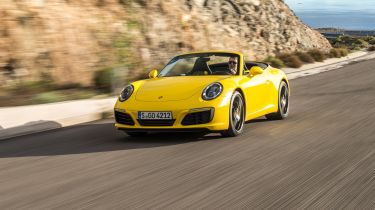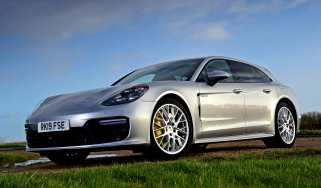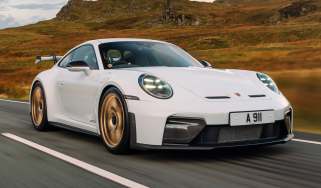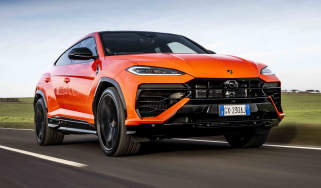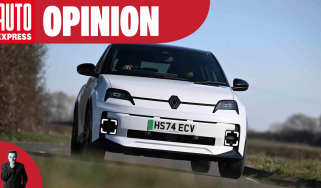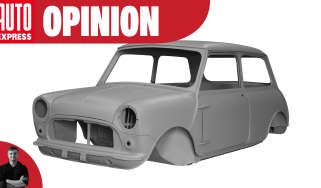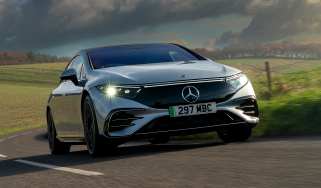Porsche 911 Cabriolet (2011-2019) review
Open-top 911 Cabriolet adds open-air dimension, while turbo power has boosted performance and economy

The Porsche 911 Cabriolet delivers the same sort of driving thrills as the coupe, but opening the roof adds another dimension to the experience. Porsche has tried to keep the focused chassis and alert responses of the 911 Coupe the same, and the Cabriolet largely manages to achieve this, although the latest Carrera Cabriolet's switch to turbo power means you don't get quite the same aural thrills as the earlier version.
Porsche first introduced the 911 Cabriolet in 1982, nearly 20 years after the original 911 coupe arrived, and 15 years after the 911 Targa, and it was the first full convertible from Porsche since the 356 of the mid-Sixties. Cabriolet versions of the 911 have been produced ever since, including limited-production Speedster and special Turbo-based models.
The current 991-era 911 Cabriolet arrived in 2012, not long after the standard Coupe. But the 911 range had an updated in 2015, when the Carrera and Carrera S models traded their naturally aspirated flat sixes for a 3.0-litre twin-turbo flat-six in two different power outputs.
This update was designed to meet new emissions regulations, but also gave Porsche the opportunity to update the car's interior and add some subtle styling revisions. There's a slightly different nose and updated engine cover, while Porsche's latest infotainment system has been introduced.
Used - available now
The 911 Cabriolet range is the same as the standard 911 Coupe. That means there are Carrera, Carrera S, GTS, Turbo and Turbo S models, while four-wheel drive is offered on the Carrera 4, Carrera 4S and GTS 4 - the Turbo models are four-wheel drive as standard. These two also get Porsche's excellent PDK twin-clutch auto as standard, while the rest of the range has it as an option. The only big difference between the 911 Cabrio and Coupe is that there are no GT versions of the drop-top.
The roof of the 911 Cabriolet opens or closes in 13 seconds, and can be operated when driving at low speeds. It's the same on all models, so is made from multiple layers of fabric, and when it's closed, it has the same profile as the coupe. Prices for the Cabriolet are a couple of thousand pounds higher than the coupe - while the 911 Targa is the same price as the cabrio - and that means the 911 Turbo S Cabriolet is the most expensive 911 in the range, weighing in at over £150,000.
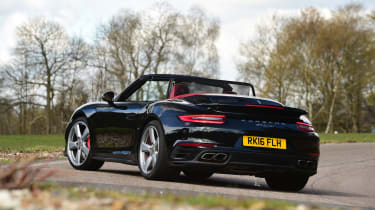
Rivals for the 911 Cabriolet are varied, due to the wide range of models on offer. The Carrera models are rivals for cars such as the Jaguar F-Type, Mercedes SL, and Aston Marting Vantage Roadster, while the faster Turbo models are rivals for cars like the Audi R8 Spyder, Lamborghini Huracan Spider and Bentley Continental GTC.
Removing the Porsche 911’s roof adds an extra dimension to the driving experience, putting the Cabriolet up against drop-top rivals like the Jaguar F-Type, Mercedes-Benz SL and Aston Martin V8 Vantage Roadster.
Like the Porsche 911 coupe, the 911 Cabriolet model neatly integrates the firm’s latest 3.0-litre turbo flat-six and has a subtly enhanced look thanks to some subtle styling changes. But while open-air thrills are on offer courtesy of that fully electric convertible roof, the 911 Cabriolet’s chassis lacks the poise and composure of its hard top sibling, thanks to the removal of the roof.
At the top of the range, the 911 Turbo delivers phenomenal performance, but it comes at a price, although buyers at this end of the market seem happy to shell out for it, especially as the 911 Cabriolet is one of the more practical drop-tops on sale.
Engines, performance and drive
Replacing the naturally aspirated engine in the Carrera and Carrera S with a smaller turbocharged unit might improve efficiency, but it unfortunately removes some of the theatre of revving out a spine-tingling engine to its limit.
Turbos work off the exhaust, with the waste gasses spinning a compressor to force more air into the cylinders, producing more power and reducing fuel consumption. But a by-product is that turbos reduce noise.
In a convertible sports car you should be able to hear the engine rasp, but in this new 911 Cabriolet that’s not quite the case. Push the accelerator and there’s an audible whoosh as the turbos build boost, but the 911’s traditional exhaust bark isn’t quite as loud. At least the Sports exhaust releases a few more decibels and a bit more character, but it’s a pricey option.
However, the Cabriolet still has enough bite, as with 365bhp on offer in the Carrera, 0-62mph takes 4.8 seconds. The Carrera S ramps things up with 414bhp, so the manual is another three tenths faster. The quickest Cabriolet on offer is the 4S with Porsche’s PDK box – with the extra traction off the line it rockets from 0-62mph in 4.0 seconds, giving it genuine pace.
But power is nothing without control, and by removing the roof the coupe’s stiff structure has lost some of its rigidity. It means over bumpy roads the Cabriolet shakes and shimmies as the suspension tries to cope with the body flex.
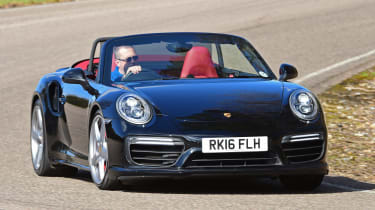
It reduces comfort when cruising while another consequence is less grip when driving faster compared to the coupe. It’s no surprise, as the roof rails add plenty of strength, but push harder and the Cabriolet’s extra flex over the coupe means the steering isn’t quite as precise either.
There’s still just enough feedback on offer to let you know what both ends of the car are doing, but even with Porsche’s Active Suspension Management now fitted as standard, it lacks that last layer of composure.
PASM also means the 911 is now 10mm lower than before. However, the switchable dampers widen this car’s breadth of ability, so it’s more comfortable in Comfort and offers extra focus in Sport. We’d suggest sticking to the default Comfort setting though, as the stiffer damping in Sport worsens the body wobble.
The 911 redeems itself with its seven-speed manual. The light shift action is mechanically precise, so you can snick through the gears. It’s helped by a new twin disc clutch, which is lighter in traffic and therefore easier to use. Go for Porsche’s Sport Chrono pack and you get a rotary control on the steering wheel to select driving modes – in Sport or Sport Plus it gives the engine a delicious blip on the way down the ratios.
Of course, the PDK paddle shift option does this too, and adds lightning quick upshifts into the mix for extra performance, effortlessly switching cogs when cruising around town or on the motorway in auto mode.
If you go for an S model Porsche’s rear-wheel steering option is available, borrowing the tech from the high-performance GT3 and Turbo models. At low speed this actually turns the rear wheels in the opposite direction to the fronts to increase agility.
Increase the pace and at high speed the rear wheels go in the same direction as the fronts to improve stability. It’s clever tech that really works, giving crisp turn-in. However, the big deal here is still the engine.
The Turbo Cabriolet has devastating cross-country pace, thanks to its 710Nm of torque and various modes that can make the gearbox shift more quickly and aggressively. Frankly, it's hard to think of more than a handful of vehicles that could keep up with the Turbo, which can reach 0-62mph from rest in just 3.1 seconds.
The rest of its drive isn't quite as sweet as the regular 911s', though; the steering in particular is affected by the four-wheel-drive system, so while the Turbo and Turbo S are the peak of the range in terms of pure performance, they're not top dogs when it comes to driving pleasure.
Engines
Throttle response can sometimes be a problem with a turbo engine, but Porsche’s engineers have worked hard to make sure when you push the right-hand pedal the 911 leaps down the road instantly.
As a result maximum torque is made from 1,700rpm all the way to 5,000rpm 450Nm in the standard Carrera and 500Nm in Carrera S models), which makes this a very flexible unit. There’s minimal turbo lag in the base model, but the S responds more crisply still.
Whereas you might have had to rev the old Cabriolet’s naturally aspirated unit hard to extract the performance, the added mid-range shove of this 3.0-litre power plant makes for more relaxing progress. It’s lost some top-end fireworks compared to its high-revving predecessor, but the car is now more usable day-to-day.
With the Sport Chrono pack you also get Porsche’s new Sport Response feature. It’s only for PDK-equipped models, but push the little red button in the centre of the drive mode selector and the gearbox down changes to the right gear, priming the engine for a burst of acceleration for 20 seconds. It works well for rapid overtakes.
The engine in the Turbo and Turbo S editions has also been upgrade for the facelift, but it's closer to what we knew before, with 3.8 litres and twin turbochargers. It does get more advanced systems designed to lower the amount of 'turbo lag' - the delay between pressing the throttle and boost being delivered to the engine - but demand performance in a higher gear and you'll still find yourself waiting for a moment or two while things crank into life.
MPG, CO2 and Running Costs
Running a high-performance sports car like a Porsche is never going to be cheap, but the manufacturer’s move to a turbo engine has improved fuel consumption and reduced CO2 emissions.
The Carrera Cabriolet manual returns official figures of 33.2mpg and 295g/km CO2. Go for the auto and this improves to 37.7mpg with an impressively low 172g/km CO2.
Unsurprisingly, the figures aren’t quite as frugal for the more powerful S model, but it still returns decent numbers, with 32.1mpg and 202g/km CO2 for the manual, and 36.2mpg with 178g/km for the PDK.
The Cabriolet also comes with four-wheel drive, so the extra drag on the engine here means it has to work slightly harder, resulting in a slight decrease in fuel consumption.
The highlight is the Carrera 4 PDK at 36.7mpg and 177g/km CO2, while the worst is the 4S manual at 31.7mpg and 204g/km CO2. However, for cars boasting 365 or 414bhp, these figures are incredibly impressive and similar to some hot hatchbacks. Just don’t expect to achieve them if you want to use any of the Porsche’s performance.
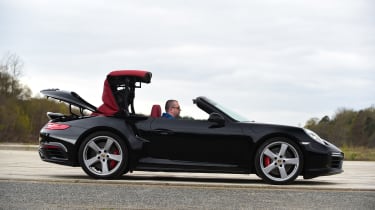
The Turbo and Turbo S models are created for those who really don't have to even look at the price tag, so it's no surprise that their efficiency figures aren't as rosy. Both cars return 30.4mpg and 216g/km of CO2 emissions.
Stop-start is standard on all models, while there’s also a coasting function to help eek as much from a tank of fuel as possible. The 911 also features some clever aerodynamics to reduce drag – including active aero grilles at the front that open and close – using less energy to cut through the air and therefore improving fuel economy.
Insurance groups
High running costs will also stem from the Cabriolet’s high insurance group ratings. The scale runs from one to 50, with 50 being the highest – every 911 Cabriolet variant comes in at group 50, so expect to pay a significant amount for 12 months’ cover on your car.
This is similar with rivals, however. Cars at this level of the market, costing this much and with similar performance to the Porsche, will all likely be rated at group 50, but with new safety tech on the 911, it should help to keep premiums reasonable.
Depreciation
Residual values for the 911 Cabriolet range hover around the 50 per cent mark, according to our experts, which means the open-top 911 is expected to hold onto around half of its value after three years/60,000 miles.
This does mean you’ll lose a minimum of around £42,000 on the least expensive Carrera Cabriolet.
Interior, design and technology
The 911 Cabriolet’s interior is carried over from the coupe wholesale, except for the fact that the roof retracts electrically, adding some open-air enjoyment. Push the button on the centre console and it takes 13 seconds for the roof to raise or lower, which can be operated on the move at up to 31mph.
There’s also a wind deflector that you can put up behind the front seats, which does a good job of reducing buffeting at speed inside the cabin.
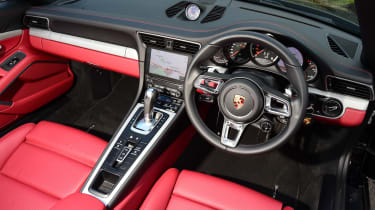
The cabin layout will be familiar to anyone who’s sat in the pre-facelift 991-generation model, as the high dashboard and cossetting centre console put the focus on the driver. Material quality is excellent and there’s a surprising amount of space for a sports car.
However, the real change for this facelifted 911 comes with the infotainment system. The seven-inch touchscreen now accepts swipe and pinch gestures, just like a smartphone or a tablet, so it’s easier to use.
Sat-nav and real-time traffic info is also standard, as is Apple CarPlay. However, there’s no MirrorLink function for Android users. Porsche has also developed a new Car Connect app, which lets owners check their car’s security status or fuel level remotely.
This new generation of 911 also features a narrower diameter sports steering wheel, which takes design inspiration from the 918 hypercar. It looks better, but it’s also more functional, making the 911 feel eager to change direction. If you want, you can also tick the GT steering wheel option box – this is even narrower again.
Other on-board tech includes an optional front axle lift system so the 911’s nose doesn’t scrape over challenging speed bumps, as well as rear-wheel steering on S models to further improve agility and stability at low and high speeds, respectively.
Adaptive cruise, adaptive LED lighting and lane keep assist are also optionally available to improve safety.
The Turbo and Turbo S editions, meanwhile, get fully electric and heated sports seats as part of an extensive standard kit list; there's also more widespread use of leather throughout the cabin, and a GT sports steering wheel.
Sat-nav, stereo and infotainment
The new PCM 4 touchscreen infotainment system is a big step on over the previous unit, and it’s much easier to use.
Being able to pair your iPhone adds extra options, too. However, as we mentioned, there’s no Android connectivity option as yet. Porsche says the majority of its customers use Apple products, so at the moment it has no plans to branch out into developing an Android Auto system.
Bluetooth is standard, while the USB socket has been moved out of the glove box and into the central cubby, improving functionality.
Practicality, comfort and boot space
Most sports cars are strictly two seaters. However, the Porsche 911 has always had an advantage here, as its two small rear seats allow enough room for children or offer extra luggage room, meaning this is a surprisingly practical car given its sloping roofline and curvaceous silhouette.
Under that low bonnet is a 145-litre boot in the two-wheel drive version. This drops to 125 litres in the four-wheel drive car due to the front differential eating into space, but in either configuration there’s still enough room for a few overnight bags.
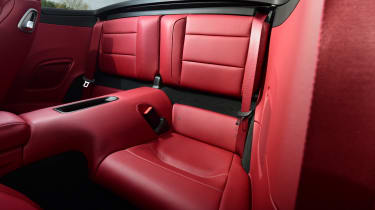
Fold down the seat backs to those small bucket seats in the back and there’s a further 260 litres of luggage room on offer.
Other practicality features include that nose lifter, improving ground clearance for steep ramps and speed bumps, as well as the view out. The low bonnet gives a great view forward, while unlike some rivals such as the Jaguar F-Type, the 911’s shape means you can see out of the mirrors and the rear screen easily.
Size
It’s no surprise the 911 has grown over the years as buyers want more practicality to go with the performance, but this is still a relatively compact sports car compared to some of its rivals.
The rear-wheel drive Cabriolet is 1.8m across its widest point – the rear wheel arches. This excludes the door mirrors, though. At 4.5m long and 1.3m tall, it’s a sleek, low sports car.
The Carrera 4 and 4S are 40mm wider due to the extra width across the rear wheels, so the body has grown to cover the increased foot print, while an LED light bar connects the cut-out 3D rear light clusters to accentuate the car’s extra width. The Turbo and Turbo S are a further 30mm wider again.
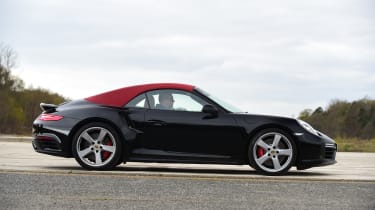
To put the 911’s size into perspective, a Jaguar F-Type is 1.92m wide and nearly as long at 4.47m. However, the Jag’s chunky C-pillars and more claustrophobic cabin mean visibility isn’t as good.
With Porsche Adaptive Suspension Management now standard, the 911’s ride height has also dropped by 10mm. That means the car sits even lower to the ground, but despite this it’s still relatively easy to get in and out of. That’s because the door sills aren’t too wide.
As you’d expect, access to the rear seats is easy with the roof down, but even with the long doors, if you’ve got the roof up it’s more of a job to clamber into the rear. One benefit of the 911’s rear-engined layout is that when the roof’s folded it doesn’t impact boot space like in some other convertibles.
Leg room, head room & passenger space
Space in the front is good – you sit low, so the dash seems high, and despite the rising centre console the 911’s cockpit doesn’t feel cramped.
The glove box isn’t huge but is large enough to offer decent storage, just like the pop-out door bins. There’s a shallow cubby under the central armrest while the pair of cupholders that pop out of the dashboard are a neat solution.
In the rear legroom is limited, as is headroom with the roof up. Adults will feel very cramped, but then Porsche doesn’t claim the 911 is able to carry four people. The seating layout is described as ‘2+2’, so the back seats are really for small children or extra luggage space.
Porsche offers an Isofix mounting point for the front passenger seat if you’ll be carrying a child seat.
Boot
Luggage space in the nose is limited, but then again, the Jag F-Type Cabriolet only has a 196-litre boot. Combined with the extra luggage room in the rear of the cabin, both the rear- and four-wheel drive Cabriolet models boast more space than the Jaguar.
Another benefit is that the luggage bay is a nice, square shape, so there are no awkward intrusions in the area where you’ll stow your bags.
Reliability and Safety
Porsche always performs well in our annual Driver Power customer satisfaction survey. Last year it finished in sixth place overall, while its dealers scored a strong result in eighth.
This new generation of 911 has brought with it a number of safety improvements, so post-collision braking is now standard to reduce the effects of any secondary impacts in the event of a crash, while a brake upgrade gives extra stopping power.
The S models feature larger discs again, while Porsche’s ceramic-composite brakes are also available as an option to really haul the 911 down quickly, resisting fade well.
There’s a new mode for the ESP system, called PSM Sport. This is a half-way house between on and fully off, which lets you have a little more fun. However, if you brake hard enough to trigger the ABS the stability control automatically cuts back in to help you out.
Euro NCAP doesn’t crash test the Porsche 911, but with a strong structure and pop-up roll over bars that emerge from behind the rear seats to protect passengers in a crash, we’d expect the 911 Cabriolet to be relatively safe. However, you have to remember this is an open car, which means inherently it’s not quite as safe as the coupe.
Warranty
All Porsche’s come with a three-year, unlimited-mileage warranty, which is the same as its major rivals and standard at this level of the market.
Servicing
Porsche hasn’t released servicing prices for the latest 911 yet, but going off prices for the previous model, it’s not going to be cheap to maintain. A minor service is predicted to cost around £485 while a major service will be around £615. This is the same for all 911 Cabriolet variants.
One saving grace is that the car’s service intervals are every 20,000 miles or two years – whichever comes first – so depending on how much you use your 911, it might not have to go in for routine maintenance quite as frequently as you’d think.

